The best weight loss workouts for beginners are those that combine cardio and strength training to burn calories, build lean muscle, and boost metabolism efficiently.
If you’re new to fitness, starting the right way can help you see faster results without injury or burnout.
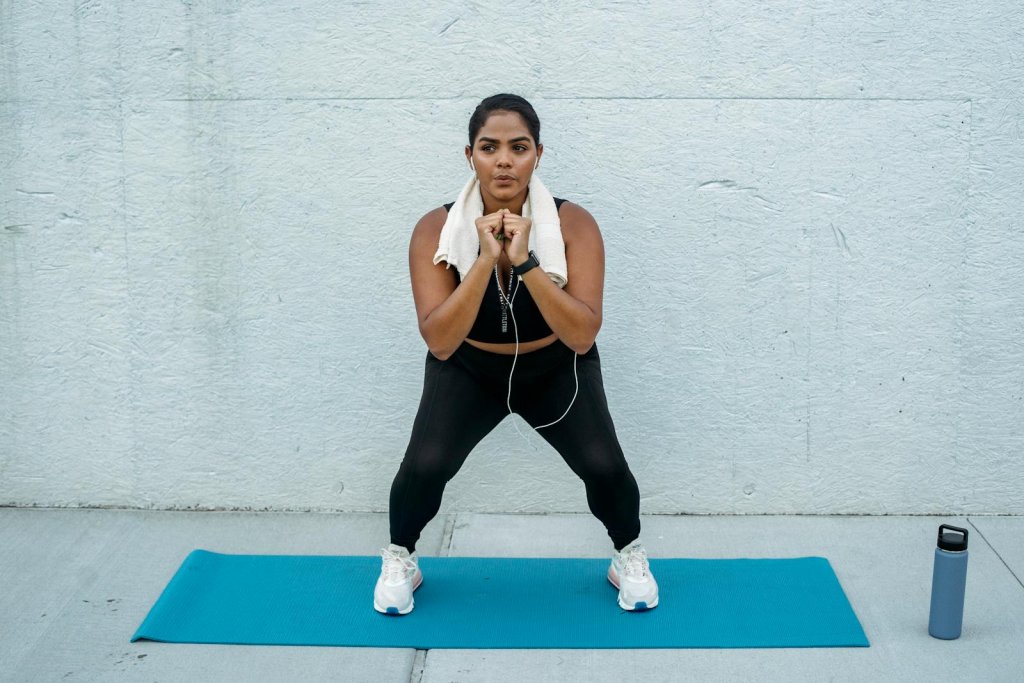
Understanding how these beginner-friendly exercises work — and how to do them safely — is key to sustainable fat loss. Below, we’ll break down 12 scientifically proven workouts that can help you burn fat, tone up, and get fitter, fast. Each one is easy to start, needs little or no equipment, and aligns with current CDC and Mayo Clinic recommendations for healthy physical activity.
Why Weight Loss Workouts Matter for Beginners
Starting a weight loss routine as a beginner is about more than just burning calories — it’s about building habits that improve long-term health.
According to the Centers for Disease Control and Prevention, regular physical activity helps reduce body fat, improve cardiovascular health, and prevent chronic conditions like diabetes and hypertension.
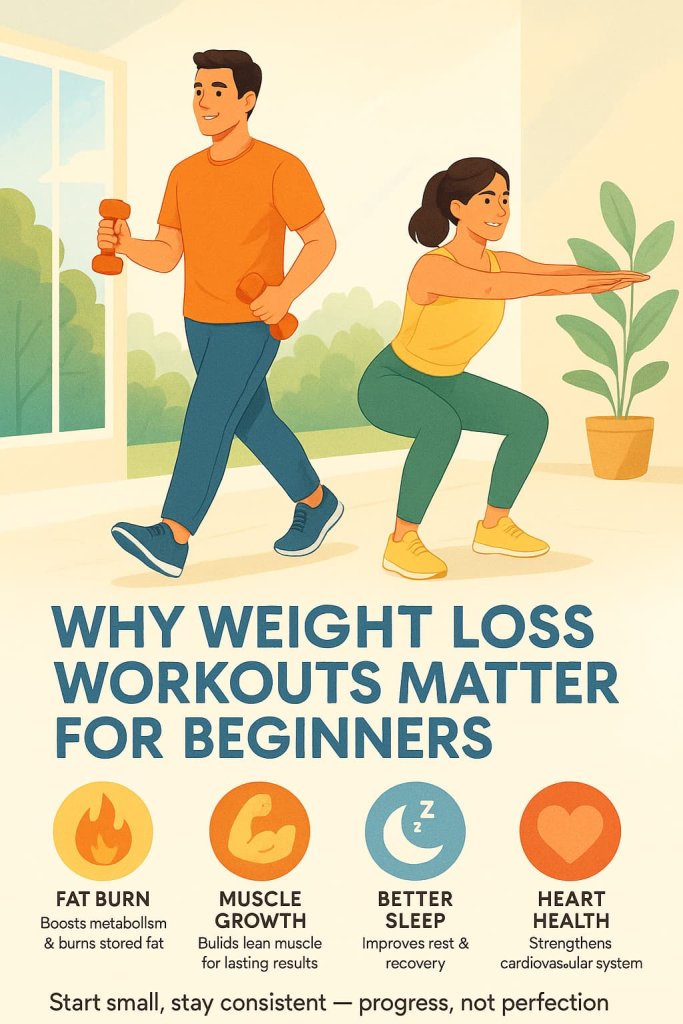
Exercise also increases energy, enhances mood, and strengthens the muscles that support posture and joint stability. Beginners who move consistently — even with light workouts — experience better metabolic function and confidence, both key to maintaining results.
Key benefits of starting now:
- Burns stored body fat and boosts metabolism
- Builds lean muscle to maintain long-term weight control
- Improves sleep quality and stress management
- Reduces risk of lifestyle-related diseases
Trainer Tip: Focus on progress, not perfection. Even small improvements, like walking 20 minutes daily, make a measurable difference over time.
How Often Should Beginners Work Out for Weight Loss
Consistency matters more than intensity when starting out.
The CDC and American Heart Association recommend at least 150 minutes of moderate activity per week or 75 minutes of vigorous activity for general health. For beginners, that translates to manageable, flexible sessions throughout the week.
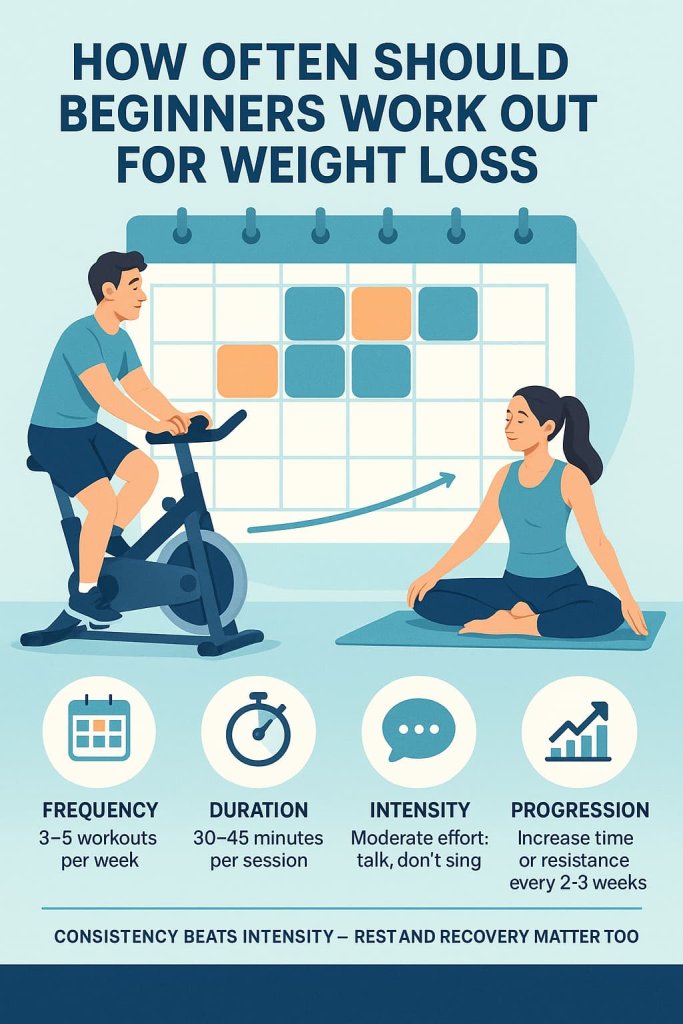
Beginner guidelines:
- Frequency: 3–5 workouts per week
- Duration: 30–45 minutes per session
- Intensity: Moderate effort — you should be able to talk, but not sing
- Progression: Gradually increase duration or resistance every 2–3 weeks
Trainer Tip: Pair every workout day with at least one rest or active recovery day (like stretching, yoga, or walking) to avoid overtraining and soreness.
12 Best Weight Loss Workouts for Beginners
These beginner-friendly workouts combine cardio and strength to help you burn fat, build muscle, and boost energy safely.
Start slow, stay consistent, and watch your body grow stronger every week.
1. Brisk Walking
Why it works:
Walking is one of the easiest and safest ways to start losing weight. It’s low-impact, requires no equipment, and can be done anywhere. According to Mayo Clinic, a 160-lb person burns around 314 calories per hour walking at 3.5 mph. Regular brisk walking also improves heart health, mobility, and stress levels — making it ideal for beginners.
Muscles worked:
Legs, glutes, calves, and core stabilizers.
How to do it:
- Walk at a moderate pace (3–4 mph) for 30–45 minutes most days.
- Maintain upright posture — shoulders back, core tight, arms swinging naturally.
- Start on flat terrain, then add light hills or longer routes weekly for progression.
Trainer Tip:
Track your steps with a pedometer or smartwatch. Aim for 7,000–10,000 steps daily to stay active and accountable.
2. Bodyweight Circuit Training
Why it works:
This training combines cardio and strength exercises in one efficient session. You’ll boost your metabolism and burn fat while improving muscular endurance. According to ACE (2024), circuit workouts can elevate heart rate to the fat-burning zone even without equipment.
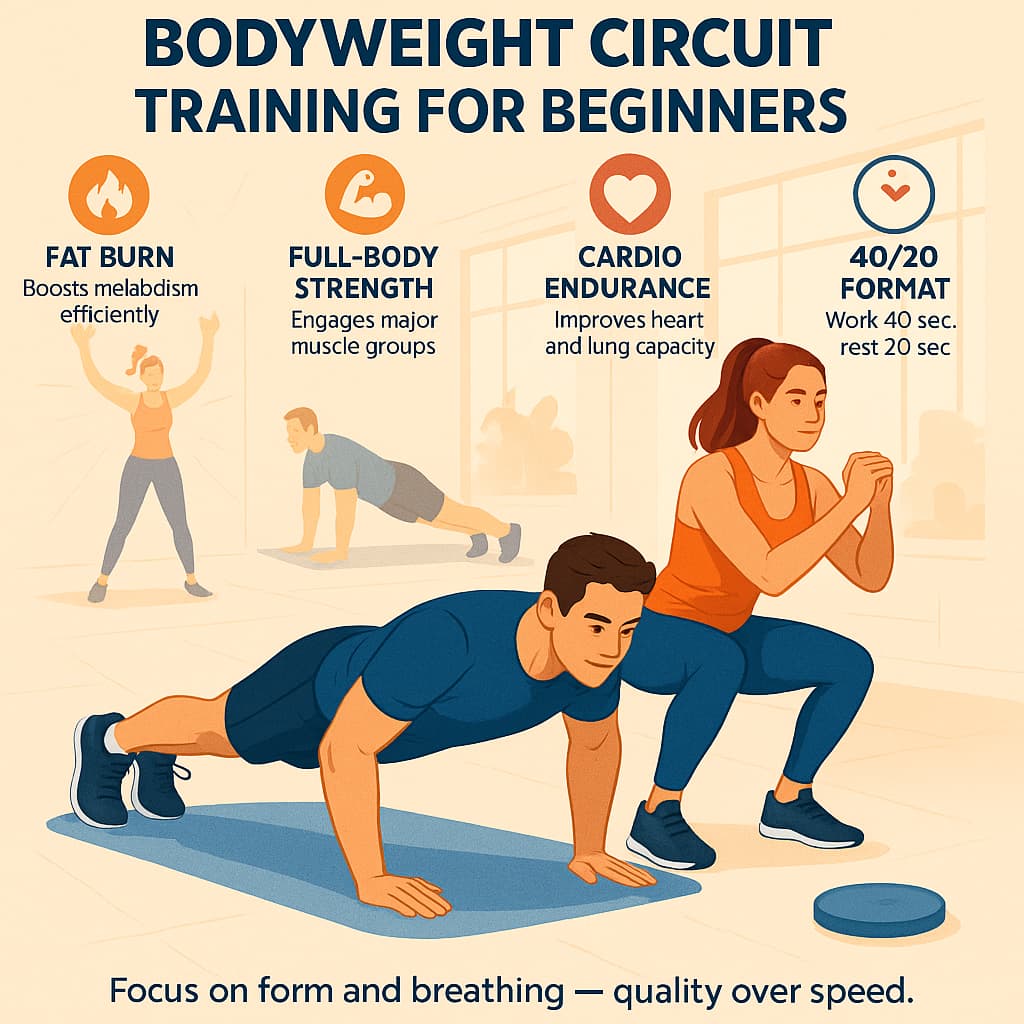
Muscles worked:
Full-body — chest, shoulders, legs, arms, and abs.
How to do it:
Perform each move for 40 seconds with 20 seconds rest between exercises:
- Jumping jacks
- Bodyweight squats
- Push-ups (modify on knees if needed)
- Plank hold
- Alternating lunges
Repeat for 2–3 rounds, resting one minute between rounds.
Trainer Tip:
Focus on controlled movement and consistent breathing. Quality matters more than speed.
3. Stationary Cycling
Why it works:
Cycling is a low-impact cardio exercise perfect for protecting the joints while still burning calories. A 155-lb person burns about 260 calories in 30 minutes at moderate effort (Harvard Health, 2024). It also strengthens your legs and improves cardiovascular endurance.
Muscles worked:
Quadriceps, hamstrings, glutes, calves, and core.
How to do it:
- Adjust the seat height so your knees are slightly bent at the bottom of each pedal stroke.
- Cycle for 20–40 minutes at a steady pace.
- Maintain a moderate resistance where you can still talk but not sing.
Trainer Tip:
Add interval bursts by alternating 3 minutes easy + 1 minute hard to boost calorie burn.
4. Jump Rope
Why it works:
Jump rope training increases coordination, balance, and endurance while torching 300–400 calories in 30 minutes.
Muscles worked:
Calves, quads, shoulders, forearms, and core.
How to do it:
- Adjust rope length so the handles reach your armpits when you step on the middle.
- Jump lightly on the balls of your feet for 30 seconds, rest for 30 seconds, repeat 10–15 rounds.
- Keep knees soft and wrists doing the turning.
Trainer Tip:
Start with short rounds and soft flooring. Gradually increase duration as your endurance improves.
5. Bodyweight Squats
Why it works:
Squats activate major lower-body muscles, boosting metabolism and calorie burn. They also improve mobility and strengthen joints. Regular practice increases everyday functional strength — essential for long-term fitness.
Muscles worked:
Glutes, quadriceps, hamstrings, calves, and core.
How to do it:
- Stand shoulder-width apart, chest tall, core tight.
- Lower your hips back and down as if sitting on a chair.
- Stop when thighs are parallel to the floor, then press through heels to stand.
Trainer Tip:
Hold the bottom position for 2 seconds to increase time under tension and control.
6. Dumbbell Strength Circuit
Why it works:
Strength training helps you lose fat while maintaining lean muscle. It raises your resting metabolic rate, meaning you burn calories even after finishing your workout (NIH).
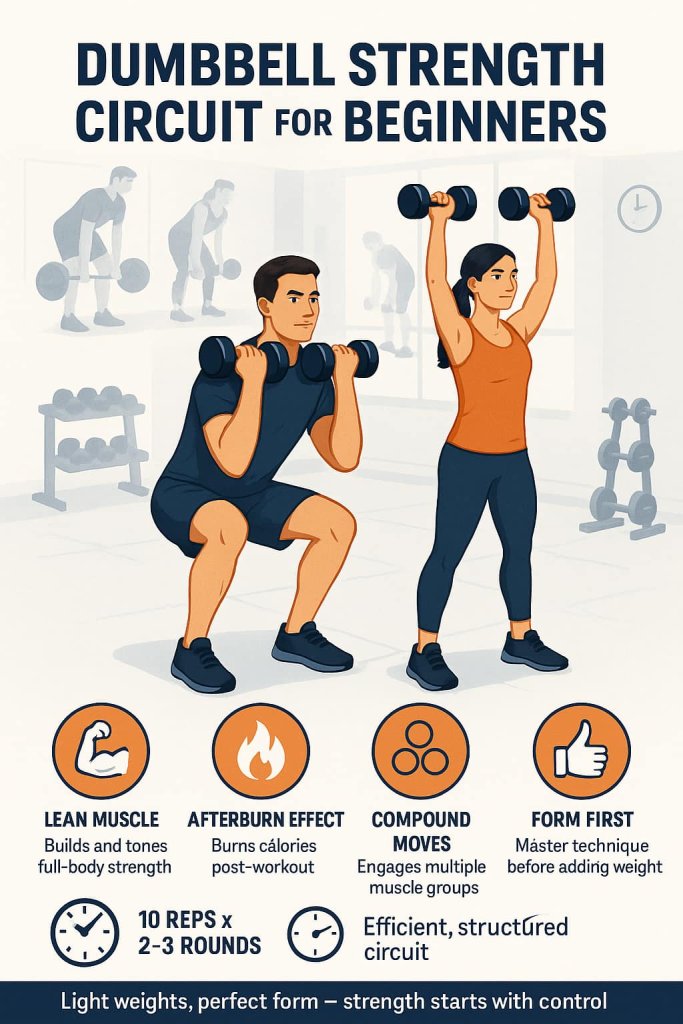
Muscles worked:
Arms, shoulders, back, chest, core, and legs.
How to do it:
Complete 10 reps of each move in sequence:
- Dumbbell squats
- Shoulder presses
- Bent-over rows
- Deadlifts
Rest 60 seconds, then repeat 2–3 rounds.
Trainer Tip:
Use light weights (5–10 lb) until you perfect your form, then gradually increase load.
7. HIIT (High-Intensity Interval Training)
Why it works:
HIIT alternates intense work with rest, allowing for maximum calorie burn in minimal time. Research (PMC) shows HIIT can produce similar fat-loss results as longer moderate sessions, improving fitness and insulin sensitivity.
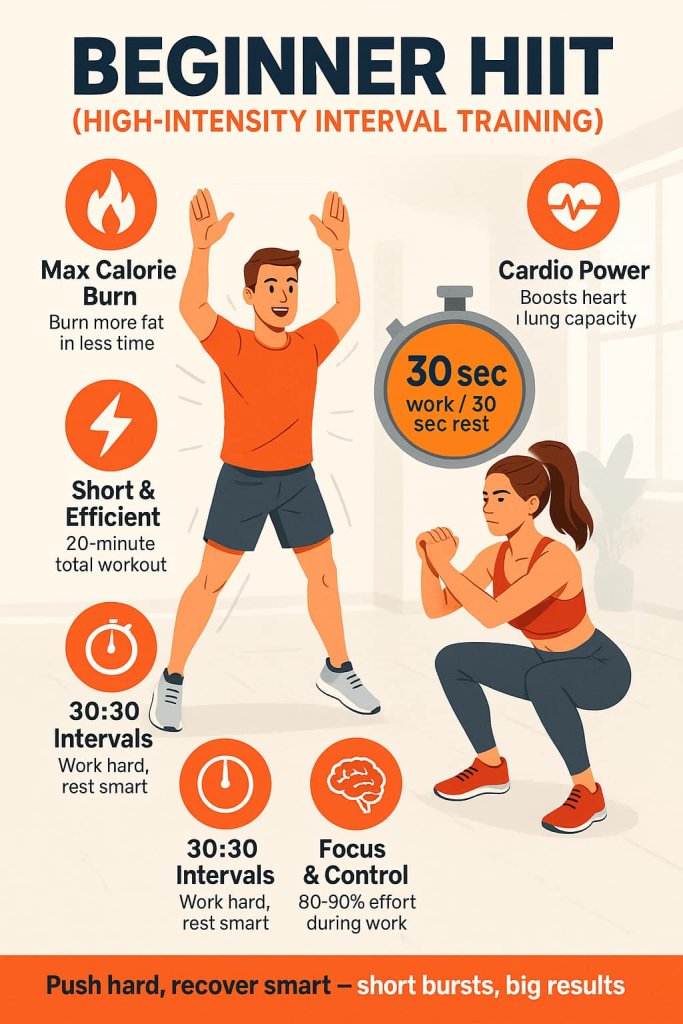
Muscles worked:
Full-body — primarily legs, glutes, arms, and core.
How to do it:
Try this 20-minute beginner HIIT:
- 30 sec jumping jacks
- 30 sec bodyweight squats
- 30 sec rest
Repeat for 8 rounds (4 cycles each exercise).
Trainer Tip:
Maintain controlled breathing. Focus on effort quality — 80–90% intensity during work intervals.
8. Swimming
Why it works:
Swimming provides a full-body, joint-friendly workout that enhances endurance and muscle tone. It’s especially effective for those with joint or mobility issues. The resistance of water increases calorie expenditure while reducing impact.
Muscles worked:
Back, chest, shoulders, arms, legs, and core.
How to do it:
- Swim steady laps for 20–30 minutes using a stroke you can sustain.
- Alternate freestyle and breaststroke to activate different muscle groups.
- Rest briefly between laps if needed.
Trainer Tip:
New swimmers can start with intermittent laps and floating recovery to build endurance safely.
9. Stair Climbing
Why it works:
Climbing stairs strengthens your legs and cardiovascular system. It’s functional (mimics daily movement) and burns 250–300 calories in 30 minutes (ACE). It’s also a natural way to build power and stamina.
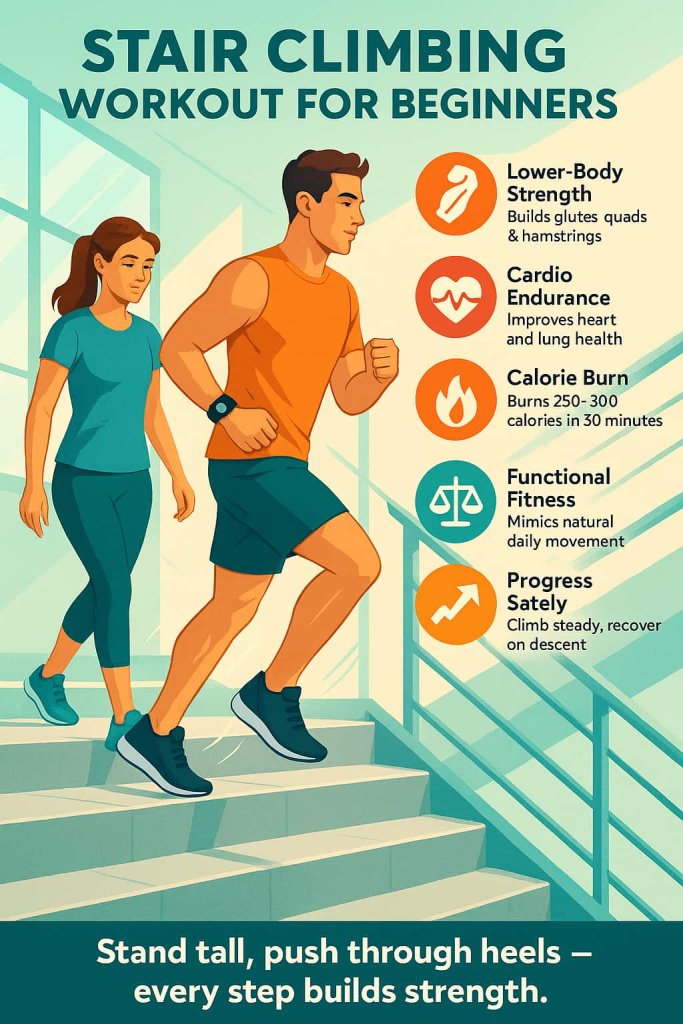
Muscles worked:
Glutes, quadriceps, hamstrings, and calves.
How to do it:
- Walk or jog steadily up a flight of stairs.
- Use handrails lightly for balance, not support.
- Walk down slowly for recovery; rest 30 seconds before the next climb.
Trainer Tip:
Maintain upright posture and push through heels to maximize glute activation.
10. Resistance Band Training
Why it works:
Resistance bands create continuous tension through each rep, improving strength, balance, and flexibility. They’re safe, affordable, and excellent for beginners training at home.
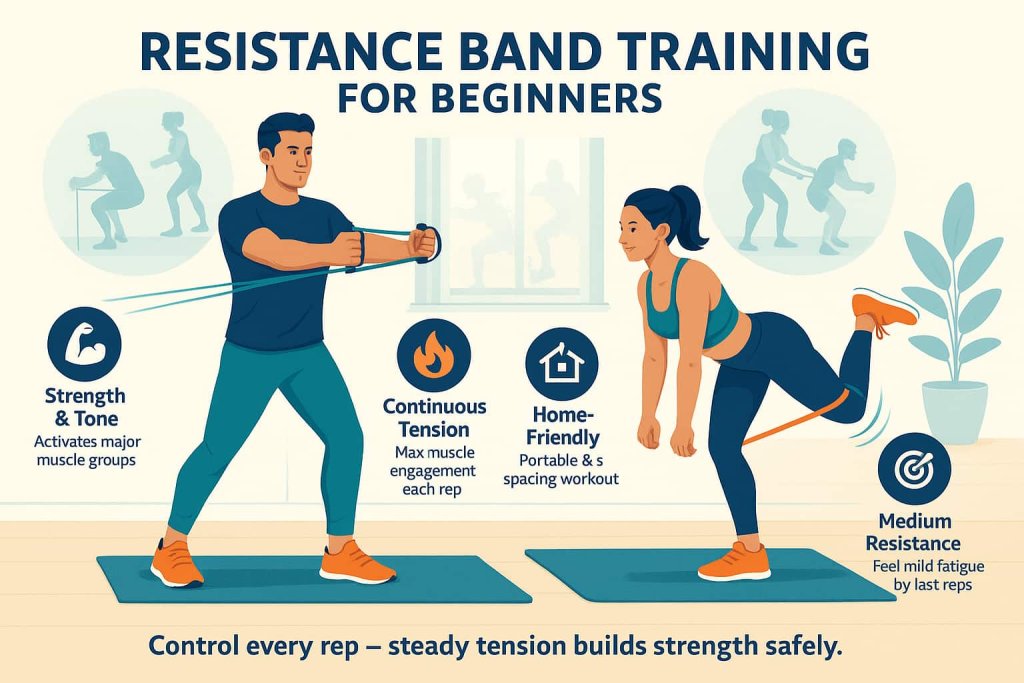
Muscles worked:
Chest, back, arms, glutes, and legs.
How to do it:
- Anchor the band at chest or door height.
- Perform presses, rows, squats, and glute kickbacks for 10–15 reps each.
- Keep controlled tension and posture throughout.
Trainer Tip:
Choose medium resistance — you should feel mild fatigue by the last few reps.
11. Pilates or Yoga Flow
Why it works:
These mindful movement workouts enhance core strength, flexibility, and balance while supporting mental well-being. Regular practice helps regulate cortisol (the stress hormone linked to belly fat) according to Harvard Health.
Muscles worked:
Core, shoulders, hips, and back.
How to do it:
- Follow a beginner Pilates or yoga video for 20–30 minutes, 3 times per week.
- Focus on posture, alignment, and breathing.
- Move slowly with control rather than rushing transitions.
Trainer Tip:
Combine yoga or Pilates on rest days to promote recovery and flexibility.
12. Dancing or Zumba
Why it works:
Dance-based workouts turn cardio into fun, social movement — helping you stay consistent. A 155-lb person can burn 250–400 calories in 30 minutes, depending on intensity (Harvard Health).
Muscles worked:
Legs, hips, arms, and core.
How to do it:
- Join a Zumba class or follow online dance workouts.
- Move continuously to the beat for 30 minutes.
- Focus on rhythm, not perfection — the goal is sustained motion.
Trainer Tip:
Use upbeat music and mirror cues to stay motivated. Consistency matters more than choreography.
Sample Weekly Workout Plan for Beginners
Here’s a balanced, evidence-based plan that combines cardio, strength, and recovery — ideal for weight loss and overall fitness.
| Day | Workout Type | Example Routine |
|---|---|---|
| Monday | Cardio | Brisk Walking or Stationary Cycling – 30 min |
| Tuesday | Strength | Bodyweight Circuit (Squats, Push-ups, Plank) – 25 min |
| Wednesday | Active Recovery | Yoga or Light Stretching – 20 min |
| Thursday | Cardio + Strength | HIIT (20 min) or Dumbbell Circuit (30 min) |
| Friday | Rest or Leisure | Light walking, stretching, or outdoor play |
| Saturday | Full Body | Swimming or Resistance Band Training – 30 min |
| Sunday | Flexibility & Mindfulness | Pilates or Yoga Flow – 20–30 min |
Trainer Tip: Schedule workouts in your calendar like appointments — consistency builds routine and results.
Tips for Safe and Effective Weight Loss
Sustainable fat loss comes from smart, safe strategies that respect your body’s limits.
Rushing progress or overtraining can lead to fatigue, injury, or rebound weight gain.
Evidence-based safety tips:
- Warm up for 5–10 minutes before every session (light cardio, joint mobility).
- Stay hydrated before, during, and after workouts.
- Prioritize form — correct movement prevents injuries and activates the right muscles.
- Rest 48 hours between intense strength sessions.
- Track progress weekly (energy, stamina, strength — not just scale weight).
- Consult your doctor before beginning any new fitness program, especially if you have medical conditions.
Trainer Tip: Listen to your body. Mild soreness is normal, but sharp pain or dizziness means it’s time to stop and recover.
Common Mistakes Beginners Should Avoid
Avoiding these common pitfalls can accelerate progress and keep you safe while training:
- Skipping Warm-ups and Cool-downs – increases injury risk.
- Doing Too Much Too Soon – leads to burnout or strain.
- Ignoring Recovery – rest days are essential for muscle repair.
- Focusing Only on Cardio – strength training is crucial for fat loss.
- Inconsistent Schedule – sporadic workouts limit progress.
- Poor Nutrition Choices – exercise cannot outwork an unhealthy diet.
- Comparing Progress – fitness is personal; focus on your own journey.
Trainer Tip: Track small wins — improved form, longer duration, or better sleep — to stay motivated without obsessing over the scale.
Nutrition and Lifestyle Tips to Support Weight Loss
Weight loss isn’t just about workouts — it’s about aligning nutrition, sleep, and daily habits for overall wellness.
According to the National Institute of Diabetes and Digestive and Kidney Diseases (NIDDK), combining balanced eating with regular exercise produces the most sustainable fat loss results.
Smart nutrition tips:
- Follow the 80/20 rule: 80% nutrient-dense foods, 20% flexibility.
- Prioritize protein: helps preserve muscle while losing fat.
- Include fiber-rich foods: fruits, vegetables, and whole grains aid satiety.
- Avoid extreme diets: they slow metabolism and cause rebound weight gain.
- Stay hydrated: water supports digestion and appetite control.
Lifestyle factors that accelerate progress:
- Get 7–9 hours of sleep per night.
- Manage stress with breathing, yoga, or journaling.
- Limit alcohol and sugary drinks.
- Move more during the day (take stairs, stand, stretch).
Trainer Tip: Focus on creating habits you can maintain — lasting results come from consistency, not restriction.
FAQs
1. What’s the best beginner workout for fast weight loss?
Brisk walking and bodyweight circuits are the safest, most effective starting points for fat loss.
2. Can I lose weight with just 30 minutes of exercise a day?
Yes — when combined with a calorie-controlled diet, daily 30-minute workouts are effective for sustainable fat loss.
3. How long until I see results?
Most beginners notice changes in 4–6 weeks with consistency and proper nutrition.
4. Is strength training necessary for fat loss?
Yes. Strength training preserves muscle mass, which increases metabolism and improves long-term results.
5. What’s better — cardio or HIIT?
Both work. HIIT saves time, while steady-state cardio is easier to sustain for beginners.
6. Should I exercise every day?
Active recovery (like stretching or light walking) is fine daily, but avoid overtraining major muscle groups.
7. Do I need equipment?
No. You can start with bodyweight moves and progress to dumbbells, bands, or home gear later.
Conclusion
Weight loss success starts with consistency — not perfection. These 12 beginner-friendly workouts help you burn fat, gain strength, and build a lasting fitness habit. Start small, move often, and increase intensity over time.
Ready to begin? Pick three workouts from this list, schedule them this week, and track your progress — small daily steps lead to big changes.
References
- CDC — Adult Physical Activity Guidelines (150 min/week + 2 days strength)
CDC - American Heart Association — Physical Activity Recommendations for Adults
heart.org - Mayo Clinic — Exercise for weight loss: calories burned in 1 hour (160-lb reference)
Mayo Clinic - ACE — Physical Activity Calorie Counter (customizable by weight, duration, intensity)
ACE Fitness - Systematic Review/Meta-analysis — HIIT vs. Moderate Intensity for Fat Loss & Fitness
PMC - Review — Resistance Training & Body Composition Improvements
PMC
